Episode 130: STS-51 - TOSsing ACTS (TOS/ACTS, ORFEUS-SPAS)
Table of Contents
On STS-51 we’ve got a packed flight with an advanced communciation satellite, a new kick stage, the return of SPAS, an EVA and a sassy air traffic controller. I hope you don’t mind a little debris in the payload bay!
Episode Audio #
Photos #
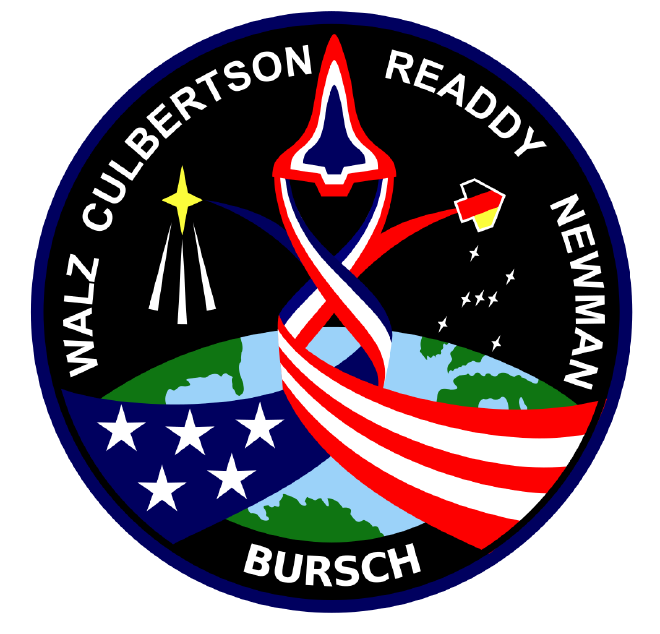
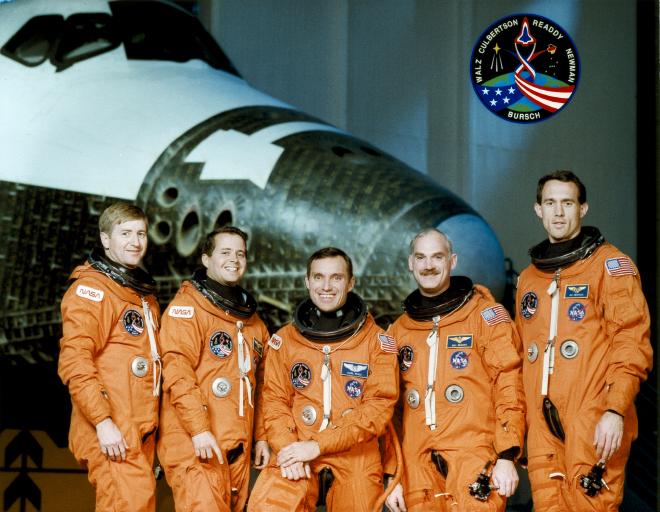
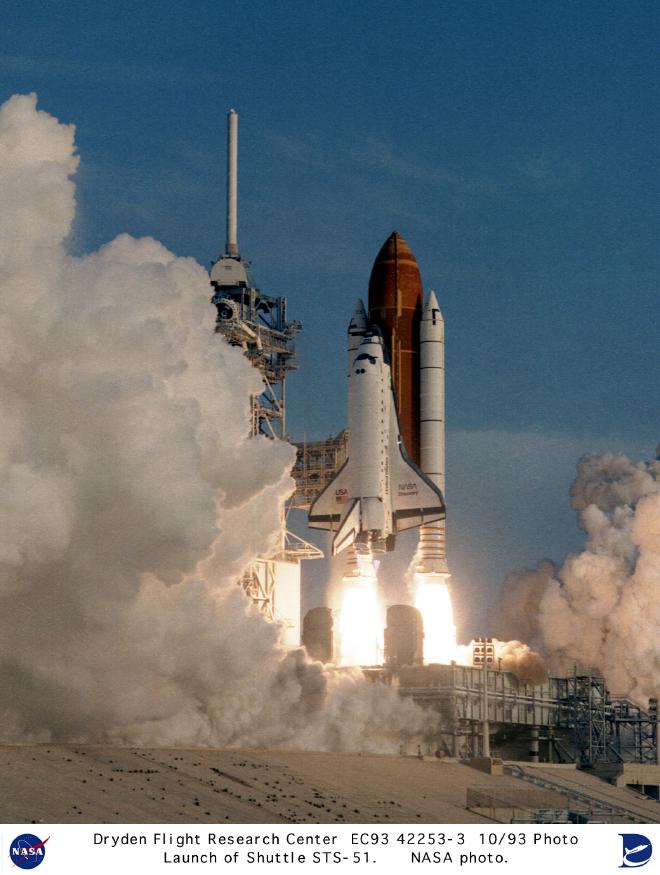
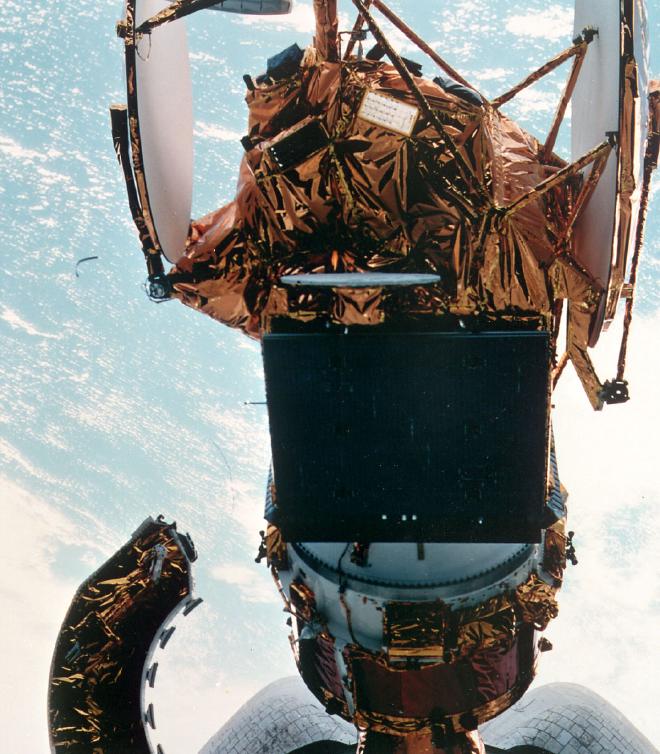
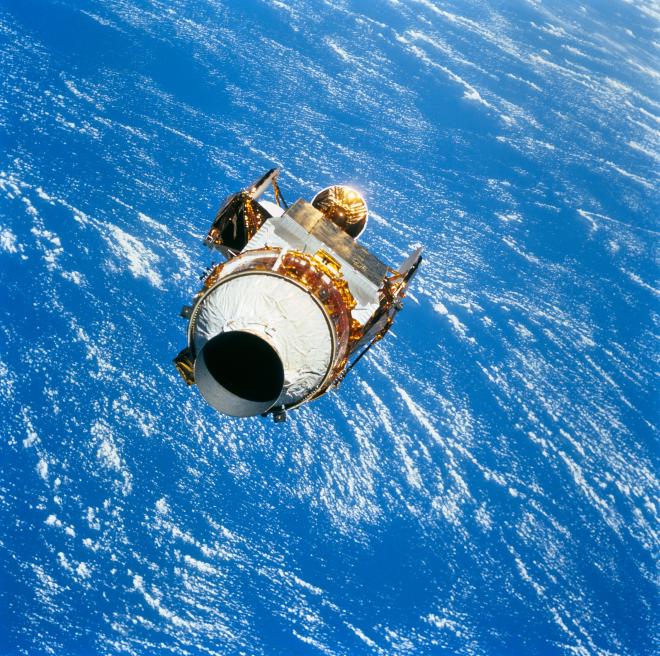
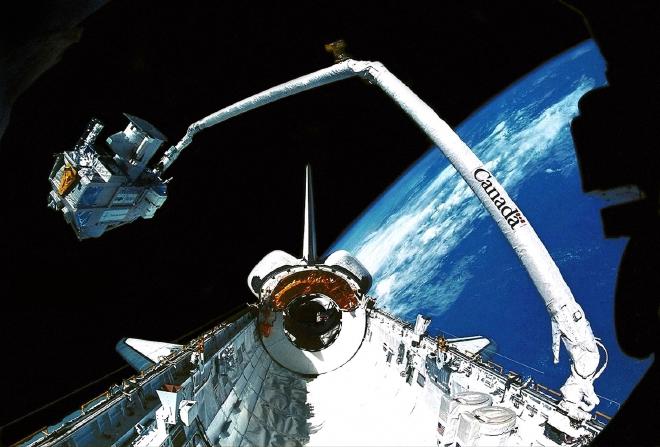
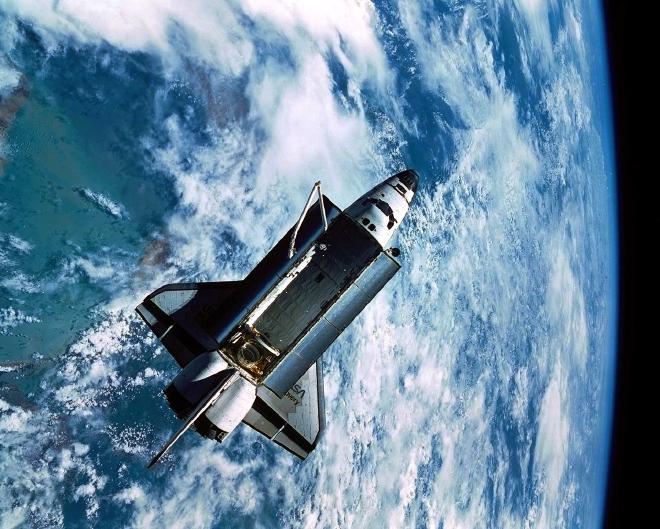
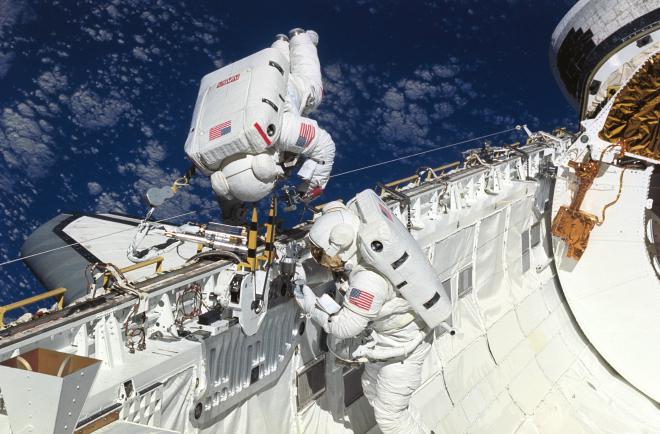
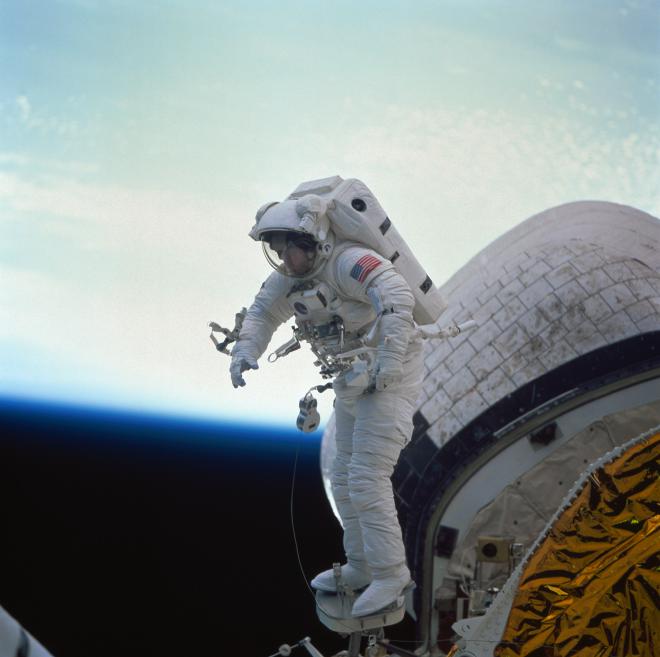
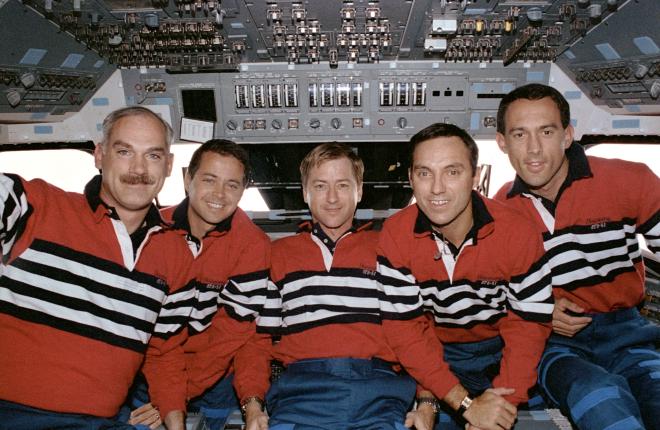
Post-Flight Presentation #
If you’d like to see the mission in motion you can check out the post-flight presentation here:
Transcript #
NOTE: This transcript was made by me just copying and pasting the script that I read to make the podcast. I often tweak the phrasing on the fly and then forget to update the script, so this is not guaranteed to align perfectly with the episode audio, but it should be pretty close. Also, since these are really only intended to be read by myself, I might use some funky punctuation to help remind myself how I want a sentence to flow, so don’t look to these as a grammar reference. If you notice any egregious transcription errors or notes to myself that I neglected to remove, feel free to let me know and I’ll fix it.
Hello, and welcome to The Space Above Us. Episode 130. Space Shuttle flight 57, STS-51: TOSsing ACTS
Last time, we took a break from the main narrative and spent nearly an hour and a half with astronaut Dan Tani. Dan wasn’t an astronaut yet when STS-51 flew, but he did work on the Transfer Orbit Stage, which served as kick stage for the ACTS spacecraft, which was deployed on this flight. We got a little preview of that deploy, and then peppered Dan with a whole bunch of random questions about spaceflight. When I started this show, I never imagined that I might actually have a chance to interview people who were directly involved in missions, let alone astronauts, so the experience was a real treat. I got a lot of positive feedback about the interview, so rest assured that we’ll have Dan back before long, and I’ll be keeping my eye out for other interview opportunities.
Before we dive right into STS-51, I have one more quick detour. As you’ll recall, ever since we sent it on its way on STS-34, we’ve been regularly checking in with the Galileo probe on its way to Jupiter. The spacecraft has covered a lot of ground since October of 1989, but still has a ways to go. When we last checked in, almost two years ago in October of 1991, Galileo had just become the first ever spacecraft to visit an asteroid, swinging past the rocky body we call Gaspra. Well, it turns out that I just completely forgot to include the next major milestone, its second flyby of Earth.
On December 8th, 1992, Galileo came screaming in along its heliocentric orbit, traveling at around 14 kilometers per second, missing the Earth by a scant 304 kilometers. That’s so close, that it was actually closer to Earth than Space Shuttle Discovery, which was partway through STS-53 at the time, albeit over a completely different part of the world. You have to have some real confidence in your guidance and navigation system to pull off a maneuver like that. Galileo piggybacked off of the mass and velocity of the Earth, gaining a extra 8.9 kilometers per second of velocity, and setting its sights squarely on Jupiter.
Well.. almost. First it had one more little pit stop to make. On August 28th, 1993, just a couple weeks before the mission we’ll be discussing today, Galileo visited its second asteroid: Ida. The spacecraft passed within 2400 kilometers of the asteroid, and in the process, discovered an even smaller asteroid orbiting it! Ida is sort of potato shaped, if a potato was around 60 kilometers long and roughly 20 kilometers wide. Ida’s moon, dubbed Dactyl, is rounder, and just a little more than 1 kilometer wide. So in the course of this one mission, humanity went from having never seen any asteroid up close, to seeing three!
Our next check-in will be in mid-1994, and was definitely not something that the original mission planners had on their schedule. Stay tuned!
OK, with Galileo continuing on its long journey, let’s return our attention to things a little closer to home. STS-51 was shaping up to be a pretty busy flight. We’ve got an advanced communications satellite that uses a new upper stage, we’re deploying our old buddy SPAS again, and to top it off, we’ve even got an EVA. That’s a lot to get done in a mission planned to last only nine days, so let’s get to it!
A central focus of this mission would be the Advanced Communication Technology Satellite, or ACTS. We’ll also be talking a fair amount about its kick stage, the Transfer Orbit Stage, or TOS, but that’ll come in later in the episode. ACTS, as is often the case with NASA acronyms, was basically what it sounded like. It was a communications satellite that used advanced technology. Specifically, it was a test bed for so-called “high risk” technology. That’s not “high risk” as in “hazardous”, but rather “high risk” as in “this is expensive and complicated and might not work like we hoped.” Why do this? Well, actually, this is a big part of what NASA’s role in the industry is, even going back to the N.A.C.A.
Making stuff like airplanes, rockets, and satellites, is expensive work that takes a lot of time and requires a lot of cutting edge technology. And if you’re a company that’s trying to make money, the last thing you want to do with your multi-year, multi-million (or billion) dollar project is take a risk on using some new and unproven technology. It would be a real bummer to spend all of that time and effort only to get to the end and realize that the technology you built your entire company around just isn’t going to work. This is where an organization like NASA can come in.
Way back in the pre-NASA days, the N.A.C.A. would do stuff like figure out the characteristics of tons and tons of different wing shapes. They built the big expensive facilities, they hired the experts, and then they just trudged through them all one at a time, publishing the results for anyone to use. That means that any new company thinking about making an airplane could get a massive head start and not worry about doing all of that basic research themselves. The N.A.C.A. was using the massive resources of the government to sort of jump-start the whole process.
And NASA did the same thing. Back in the 1960s and 1970s, they designed and flew a number of communications satellites, figuring out what worked and what didn’t work, and then giving the results away to industry. The idea was that while it wasn’t a great thing to spend taxpayer money on a technology that didn’t work out, NASA was big enough to survive that. It wasn’t going to go bankrupt. So they could try the 9 things that didn’t work before discovering the 10th thing which worked so great that it made up for everything else.
In the 1970s, NASA got out of the communications satellite game, figuring that they had done their part to jump-start this massive sector of the aerospace industry, and the companies could take it from there. After all, now they were big and had enough resources to take a few risks on their own. Unfortunately, it seems it didn’t really work out that way. So in 1983, NASA began working on the Advanced Communication Technology Satellite. By rolling the dice on tricky new technology and actually getting it working, NASA hoped to once again move the state of the art forward, and pull the whole industry along with it.
So what is ACTS? At its heart ACTS was a big ol’ box full of electronics, containing the core systems. Inside the box, or “bus” if we want to sound professional, were propulsion systems, command and control equipment, advanced signal routing equipment, and smaller antennas so that the spacecraft could be controlled from the ground. On either side of the bus were two large solar arrays, spanning 14 meters from tip to tip. Perpendicular to those were two large circular antennas, with one measuring 3.3 meters across, and the other measuring 2.2 meters across. Once fully deployed and in its control box on the GEO ring, it was three-axis stabilized, keeping its antennas facing the Earth, keeping its solar arrays facing the sun, and leaving spinning spacecraft, for the most part, in the 1980s.
All of that equipment was put to use providing the first ever Ka-band communications service, which offered 5 times more bandwidth than the lower frequencies that has been used up to this point. In addition to having multiple fixed beams, which would remain pointed at high traffic areas, ACTS could rapidly swing multiple “hopping spot” beams around from client to client on the ground, sending the signal where it was needed when it was needed. And while the latency up at GEO is always going to be a little rough due to the speed of light, it could enable gigabit communications between customers on the ground. The press kit compared it to having the benefits of fiber optic lines, but anywhere on Earth, without the need to actually lay a bunch of fiber.
Once it was fully checked out, ACTS had two years of experiments with dozens and dozens of government agencies, universities, and companies, all lined up and ready to go. These experiments were designed to see how easy or difficult it was for these various entities to integrate satellite communications into their workflow. I think the idea here is that at the end of the 2 years, the ACTS team could go to satellite companies and say “see? look? we used this thing for two years, it worked great, and all of these companies loved it and are eager to pay for more. why don’t you go take this technology and these proven procedures and make a bunch of satellites based on the same idea.”
What’s kind of funny is that when I read through the experiments, I was momentarily confused what the big deal is. I had to remind myself that when this satellite was launched in 1993, and especially when it was first envisioned in 1983, the world was a very different place than it is now in 2021. Let me give you an example. One experiment mentioned how quote “Georgetown University will investigate the viability of two-way, interactive distance learning, involving programs that are medical, scientific, or research in nature.” Or how some hospitals would be using the system to send diagnostic MRI images from Hawaii to Washington DC. uhhh, ok? These days, there are dozens of services that provide services like this on demand.. for free! But back in the early 90s, you might think twice about making a phone call across the state, let alone the country, or entire planet!
So we might be able to chuckle at this in 2021 where we live and breathe the internet, and everybody’s pocket contains an incredibly powerful communications device, but in 1993, with the world wide web just a few years out of CERN, this kind of high bandwidth worldwide communication was a pretty big deal.
All in all, I think this is a pretty cool program. It’s NASA doing what no individual company could easily afford to do, taking the big risks, trying the risky new tech, and pulling the entire industry forward in the process. So let’s meet the crew that gets to usher it into orbit.
Commanding STS-51 would be Frank Culbertson, who we know from his flight on STS-38. We may not know much about what the classified mission did, but we do know that Culbertson flew as a Pilot. This is his second of three flights, and to give you an idea of how close we’re getting, his third flight will be a multi-month stint on the ISS. The space station era is rapidly approaching..
Joining Culbertson at the front of the flight deck and serving as Pilot, was Bill Readdy. We know Readdy from his flight on STS-42, which flew the International Microgravity Laboratory. On that flight he was a mission specialist, but by serving as MS2, the flight engineer, and helping out on the orbiter crew, instead of the science crew, he clearly had his eye on the front of the cockpit. This is his second of three flights.
Moving back, we meet the first of our three mission specialists, who are all rookies! Mission Specialist 1: Jim Newman. James Newman was born on October 16, 1956 in what is now the Federated States of Micronesia, but would tell you that his home town is San Diego, California. He earned a Bachelor’s Degree in Physics from Dartmouth University, and a Masters’s Degree and Doctorate in Physics from Rice University. You know, the one where President Kennedy gave his famous “we choose to go to the moon” speech. After earning his Doctorate, he stuck around at Rice, eventually becoming a Physics and Astronomy professor. He got his start at NASA as a trainer at the Johnson Space Center, focusing on Orbiter propulsion, guidance, and control. He also worked a Simulation Supervisor, or SimSup, where it was his job to throw diabolical failure scenarios at crews and mission controllers in order to make the real missions seem easy in comparison. Ben Evans’ book “Partnership in Space” relays an anecdote from astronaut Tom Jones’ book “Sky Walking”, so this is a secondhand anecdote, but it’s too good to pass up. Apparently, even after being selected as an astronaut in 1990, Newman had trouble letting go of his SimSup roots. While on a simulation run commanded by the legendary John Young, Newman sneakily pushed the button to shut down one of the main engines, forcing Young to execute some dynamic maneuvers to rescue the simulated orbiter. When Newman revealed that he was the responsible party, Young thought it was hilarious. This is Newman’s first of four flights.
Alongside Newman was Mission Specialist 2, Dan Bursch. Daniel Bursch was born on July 25, 1957, in Bristol, Pennsylvania, but calls Vestal, New York home. He earned a Bachelor’s degree in Physics from the US Naval Academy, and 12 years later, earned a Master’s in Engineering Science from Naval Postgraduate school. In between that, he did a whole bunch of stuff with the Navy, including serving on an aircraft carrier and going through the Navy Test Pilot School both as a student and an instructor. He was selected as an astronaut in 1990, and this is his first of four flights.
And finally, down on the middeck, we’ll meet Mission Specialist 3, Carl Walz. Carl Walz was born on September 6th, 1955, in Cleveland, Ohio. Walz holds a Bachelor’s degree in Physics, and a Master’s in Solid State Physics, which he put to use in the Air Force, studying radioactive samples from the Atomic Energy Detection System. From there, he became a Flight Test Engineer at the Air Force Test Pilot School at Edwards, and then served as a Flight Test Engineer for the F-16. He was working on avionics and armament development for the F-16C when he was selected as an astronaut in 1990. This is his first of four flights.
Our pilot crew had both flown before, but all of our mission specialists were rookies, so I’m sure that they were eager to get this flight underway. Unfortunately, they were going to have to settle in for a pretty long wait, since STS-51 was one of these cursed flights where anything that could delay the flight, did delay the flight.
The first launch attempt was scheduled for July 17th, 1993, but only made it as far as the T-20 minute hold. At that time, the mission was scrubbed due to the pretty alarming discovery that the electronics responsible for controlling the various explosive bolts on the shuttle system, the Pyrotechnic Initiator Controllers, had become armed, all on its own. It would’ve been a pretty bad day if it started popping the massive bolts that were responsible for holding the SRBs onto the Mobile Launch Platform. Later analysis showed that the circuit boards responsible had become too hot and warped, allowing components that should not touch each other.. to touch each other. Not great.
A week later, on July 24th, it was time to try again, with launch attempt 2. This time, the countdown went perfectly.. until the T-20 second mark. Right around that time, a bunch of machinery is just starting up. One of those bits of machinery is the Hydraulic Power Unit that controls the thrust vector controls for the solid rocket boosters: basically, the thing that lets the SRBs steer themselves. It seems that the hydraulic power unit in the right-hand SRB had only spun up to around 65,000 rpm, instead of the minimum required value of 66,200 rpm, and that was the end of that run. The crew climbed out with another delay to look forward to. Just to pile on, the rescheduled launch had to be pushed even further back due to something outside of anybody’s control: the Perseid meteor shower. In early August, the Earth sweeps through the dust cloud left behind by the comet Swift-Tuttle. This cosmic dust burns up in our atmosphere, leading to a pretty light show on the ground, but it also slightly increases the chances of the orbiter being struck by a micrometeoroid and damaging something. So it was best to wait
OK, time for Launch Attempt number 3! On August 12th, after dealing with over-eager Pyrotechnic Initiator Controllers, under-eager hydraulic power units, and inconvenient cosmic dust, everything was finally going smoothly. Until T-5 minutes. Gahhh, what now? Actually don’t worry. There was a communication interruption between different teams on the ground, but this delay only lasted a few minutes before the count was able to continue. At long last, the space shuttle main engines fired up, one by one.. and then shut down. As the wide-eyed crew looked over a control panel covered in red lights as the shuttle stack swayed back and forth, ground controllers scrambled to ensure there had been a clean shutdown and that nothing was on fire.
Well, as scary as an RSLS abort always is, Discovery and its crew were fine. It seems that 0.6 seconds after igniting, SSME number 2 got a reading it didn’t like from a fuel flow sensor, and decided to call the whole thing off. You will not go to space today. Once again the crew unstrapped and returned to Earth the boring way, on the elevator, surely wondering when their luck would turn around. All three main engines would be swapped out to be safe, leading to a new launch date almost a month later, on September 10th.
Since it would take a while to swap out the engines, the crew hopped into their T-38 jets and set a course back across the Gulf of Mexico to Houston, which gets us a great little story as told in an oral history with Pilot Bill Readdy. The T-38 only seats two people, so each pilot crew member was paired up with a mission specialist, but that left one mission specialist without a pilot. No problem, once again I get to bring up John Young, since he was happy to fly the third mission specialist in the back of his T-38. Hey, any episode where I get to bring up John Young twice is a pretty good episode. As Readdy tells it, they were flying along, and air traffic control noticed that these three planes all had NASA call signs. ATC asked if they had heard about the scrub. An annoyed crew, fresh off of their third scrub, said that yeah, they’d heard about it. ATC asked if any of them were astronauts. Commander Culbertson responded “Well, yes, yes we are.” “Oh that’s great, have any of you flown?” “Well, some of us have and some are going to fly real soon.” The snarky ATC guy responds “Well I guess that makes some of y’all astronauts ,and some of y’all astronaut-wannabes.” That’s when John Young decided to cut the tension by quipping back “And some of us are astronaut has-beens.” I doubt the ATC guy had any inclination that he was talking to the 9th person to set foot on the moon. John Young’s great.
While the crew waited for the orbiter to be prepped for yet another launch attempt, bad news arrived from out of town. Way out of town. We don’t have time to get into all the details on this one, but on August 21st, the Mars Observer spacecraft, just three days away from arriving at the red planet, disappeared. Some technical fault had killed off the spacecraft before its primary mission could ever get underway. Suspicion fell onto a particular transistor used on the Mars Observer, and STS-51 was delayed a further couple of days while it was verified that the same transistor was not used on TOS or ACTS. Incidentally, the upper stage responsible for sending the Mars Observer on its way was none other than TOS, on its first flight, riding on Titan III rocket.
OK!! Let’s try this once again. Launch Attempt number 4. Pyro controllers calm, hydraulics fast, communications working, comet dust gone, transistors good, let’s get this show on the road already! At 7:45 am, Eastern Time, with no unscheduled delays or holds, Space Shuttle Discovery lifted off, and STS-51 was finally underway.
Now that we’re finally on orbit, we can open the payload bay doors, and get ready to deploy ACTS. But first, let’s learn a little bit about the Transfer Orbit Stage, or TOS. We learned a fair amount about TOS on the previous episode, and while I generally count on my audience to listen to all the episodes, I figured that with an 80-plus minute episode I should maybe not make that assumption and just throw in a quick recap.
The TOS was a commercial competitor to the Inertial Upper Stage, or IUS, that we’ve seen fly on a number of shuttle missions. These upper stages were given the job of taking a payload from the low orbit used by the shuttle, and sending it somewhere else. Most commonly, that “somewhere else” is up to the geostationary ring, around 35,000 kilometers above the surface of the Earth. In the case of the IUS, we had two small solid rocket motors. One would raise the high point of a spacecraft’s orbit, called the apoapsis, up to GEO. Once there, the second, smaller, motor would fire, raising the low point of the orbit, the periapsis, circularizing the spacecraft’s orbit. With the TOS, we’ve just got that first stage, leaving the job of circularizing the orbit to the spacecraft itself. That’s a bit of a trade-off since having to complete GEO insertion on your own is a bit of a hassle, but it also means that the TOS can be simpler and cheaper, which is nice.
It’s sort of a funny glimpse into the world of aerospace engineering that despite TOS being a commercial competitor to IUS, they actually used the same solid motor, the ORBUS-21. The overall TOS was being made by Orbital Science corporation, but it’s not like they would build everything themselves. Martin Marietta handled the actual construction, and a variety of other companies were hired to provide whatever specialized component they brought to the table, with United Technologies bringing the ORBUS-21 solid rocket motor. Small world. It reminded me of how some of the companies that made stuff for Spacelab found themselves making nearly identical products for Spacehab just a few years later.
Other components that allowed TOS to do its job were a fiber optic gyroscope, that used lasers in glass fibers, with no moving parts, to help determine its orientation, and 12 small hydrazine thrusters, to provide attitude control. All of this had the ACTS spacecraft mounted on top of it, and was then loaded into a special cradle in Discovery’s payload bay, where it could safely be carried to orbit.
So that’s where we find TOS now, sitting at the aft of the payload bay, ready to do its thing. The crew worked through the deployment checklist, ensuring that the TOS and ACTS had survived the trip to orbit intact, confirming that the guidance and communications systems were working, and tilting the cradle back 45 degrees so that when deployed, it would sail over the crew cabin. The schedule called for ACTS to be sent on its way only 8 hours into the flight, and when that time came, the crew called down to make sure that they were good to go.. only to get nothing in response. They tried raising the ground again and got nothing. Readdy noted in his oral history that it was pretty ironic that they were supposed to be deploying a next generation communications satellite.. and couldn’t communicate!
With no word from the ground, the crew did what astronauts did best: fell back on their training, and worked through the checklist. This involved digging out the so called “malf” book, short for malfunction, and methodically working the steps one by one. Just in case the ground was able to hear them, the crew kept narrating what they were doing, when, and why. Sure enough, the ground could hear them, and were keeping track of the crew’s work so they could stay in sync. When the lengthy procedure was finally complete, communications had been restored. The culprit? It turns out that when the crew enabled their communications link to the payload, called the payload interrogator, or PI, in order to assess how ACTS was doing, the PI’s frequency interfered with the frequency the shuttle was using for TDRSS. Basically, the orbiter had gotten itself confused and locked onto the payload interrogator instead of TDRSS. Or as Readdy put it, quote, “We had essentially jammed ourselves.”
No matter though, that’s what backup deploy opportunities were for. So just one rev later, at a mission elapsed time of 9 hours and 28 minutes, the crew flipped the appropriate switches on the flight deck, the connection between the TOS and the support cradle was severed, and the TOS/ACTS stack soared overhead. After a few small burns by the shuttle, and a little time to build up the distance between the spacecraft and the orbiter, TOS fired up, and successfully steered ACTS onto a geostationary transfer orbit. ACTS would go on to complete all of its mission objectives, remaining operational all the way until 2004.
Well that was nice. A little tech hiccup is always interesting since we get to see how the crew work around it, but all in all that deployment went nice and smoothly. Well. Mostly. Less smooth is what TOS left behind. The day after the ACTS went sent off to GEO, the crew were using the remote manipulator system to unberth an experiment we’ll be talking about in a few minutes, and they gained a clear view of the empty cradle ACTS had left behind. They immediately noticed that hanging off of the support equipment were some gnarly sharp metal rings. Sure enough, video footage of the deploy was reviewed, and a number of pieces of debris could be seen flying out into space with the communications satellite. Clearly something had gone awry with the deploy.
Well, thanks to Dan Tani on the previous episode, we know all about what happened, but let’s recap.
The Transfer Orbit Stage was attached to its support cradle by a cylindrical mechanism called the SuperZip. This thing’s whole job was to provide a stable mechanical connection between the TOS and the cradle until it was time for them to go their separate ways. When that time came, the SuperZip needed to guarantee a nice clean separation, with the full circumference of the connection popping open at the same time, so nothing gets stuck or tipped into a weird spin. There’s lots of different ways you might be able to do this. Just as an off the top of my head example, maybe you have a few latches that hold onto the spacecraft, and when it’s time to deploy, the latches are pulled back. Sounds reasonable, but as we learned through several Apollo dockings, latches can be really finicky. And as we’ve learned on just about every mission ever, mechanical devices in space can be a big source of unpredictable trouble. So a simple design with few moving parts is best.
So rather than some intricate mechanical system, the SuperZip relied on a thin piece of metal and a pyrotechnic charge. This charge was similar to detcord, the explosive cable-like material used by demolition crews. The explosive lined the circumference of the SuperZip, and when triggered, would suddenly deliver a jolt of force to the metal component that held the whole thing together. This metal component was designed to cleanly break when that force was applied. The mental image I use is like a perforated piece of paper, a special area of the material that’s designed to break cleanly. The metal wasn’t perforated, but it was sort of the same idea.
To sum that up, the crew would trigger an explosive charge, which would force a specially crafted piece of metal to deform and break in a clean and predictable way, freeing the payload.
But, and you knew there was a “but” coming, here’s where we get into the weeds. You can imagine the explosive charge as a circle, lining the interior of the cradle, with both ends of the circle being right next to each other. You can trigger the charge from either one of these ends, but just to be safe, it was actually triggered from both ends. These two ends were labeled Primary and Backup. You can imagine the explosion starting at the 12-o-clock position, where the two ends meet, and then simultaneously moving around clockwise and counterclockwise, meeting at 6-o-clock. If either the primary or the backup failed, the explosion would just continue past 6 and work its way back up to 12, all in a fraction of a second.
So again, summing that up, the explosive charge had two ends, Primary and Backup, which were both fired at the same time, with the explosions from either end meeting somewhere in the middle.
OK great, sounds simple enough. But once if all of that fails? We can’t just send someone out an EVA with an ax to cut through the Super*Zip, as much fun as that might be. So right below the explosive ring is a second explosive ring. We’ll call the first one A and the second one B. The B cord had the same setup with two ends, each labeled Primary and Backup, and just like the A cord, if it was commanded to fire, it would fire from both ends at once. But, and this is important, the system was not designed to fire both the A cord and B cord at the same time. That would be too much explosive force. The B cord was only there so that if the A cord failed entirely, there was another option. You might even call it.. a backup. And there’s the problem.
This confusing terminology lead to an improperly wired system. So when the crew triggered the primary and backup of the A cord in the TOS, instead of firing both ends of the A cord, it fired one end of both the A and B cords. Both cords detonated! The result was that instead of gently breaking the metal and popping TOS off the cradle, it just completely shredded it. TOS and ACTS were unaffected by the unexpectedly violent departure, but it still left its mark. When Discovery eventually returned home, technicians found 36 places where debris from the Super*Zip had impacted the orbiter. These impacts tore the thermal lining of the payload bay and thermal blankets, left gouges on wire trays, and one piece of debris actually penetrated the aft bulkhead, into the space where the main engines are.
This was a really really big deal, and it just goes to show how unforgiving spaceflight can really be. It’s not just that the space environment itself can be so demanding, but also that the engineering environment is demanding. As I mentioned on the previous episode, you’ve got Orbital Sciences coordinating the TOS, you’ve got Martin Marietta constructing it, you’ve got United Technologies making the SRM, you’ve got the Super*Zip coming from another manufacturer, you’ve probably got the support cradle coming from another manufacturer. All of this is being attached to the ACTS, made by another company, and then loaded into the Orbiter, made by another company, by technicians who might work for the government or yet another company. The result is interfaces on interfaces on interfaces on interfaces. And everything has to work exactly as advertised or suddenly you’ve got metal debris splattered all around your payload bay. So one bit of confusing terminology (is it A or B or Primary or Backup) can end up causing real world damage.
If you’re curious how this wasn’t caught before, this is the best and worst part. Dan might correct me later, but according to PLT Bill Readdy in his oral history, the problem was that thanks to the confusing terminology, the test equipment also had things wired up wrong. So every time tests were done on the ground, it seemed to respond exactly as expected. Every little thing will get you..
OK, well, that’s all pretty scary, even if it was a near disaster, it wasn’t an actual disaster, so we can digest that later. In the meantime, we left our next focus hanging on the end of the RMS. It’s time to meet ORFEUS-SPAS.
Well, one of those words makes sense to us, we know the Shuttle Palette Satellite, or SPAS, from a number of flights, going all the way back to STS-7. This German-built free-flying spacecraft was proving to be a pretty handy little device. As usual, for today’s mission we’ve got a whole bunch of different instruments attached to SPAS. In this case, we’ve got ORFEUS, IMAPS, SESAM, and RICS. Oh good, more acronyms to unpack.
Let’s start with the big one: ORFEUS. ORFEUS stands for Orbiting and Retrievable Far and Extreme Ultraviolet Spectrometer, and it did exactly what it says on the box. Using its one-meter mirror, it would be studying some of the hottest gases in the galaxy, which put out ultraviolet light, which we can’t see from the ground, so we brought this thing to space.
Alongside it, we have IMAPS, which is really its own independent experiment. The Interstellar Medium Absorption Profile Spectrograph, or IMAPS, had flown before on sounding rockets, but was going to get a lot more observation time on this flight. Its job would be to scope out the gasses drifting between the stars. By combining its findings with ORFEUS, scientists would learn a whole bunch about how stars are formed.
SESAM, which stood for Surface Effects Sample Monitor, was simple enough: it was just a passive little box full of different materials that were being considered for future space-based detectors. By exposing them to space, scientists and engineers would get an idea of what materials to use when designing new telescopes and experiments.
And lastly, RICS, which stood for the Remote IMAX Camera System, which is two acronyms in one! The IMAX format uses much bigger film than traditional movies, leading to incredibly detailed images. By placing an IMAX camera on ORFEUS-SPAS, audiences were treated to some of the most spectacular images ever taken of the space shuttle while in orbit. Footage from this mission was used in the films Destiny in Space as well as Space Station 3D, which aren’t too hard to find copies of these days. I gotta tell you, there’s only a few minutes of footage from STS-51 in the film Destiny in Space, but it is simply stunning. It gave me just a little taste of what Bruce McCandless must have experienced when he took the MMU out and turned around to look back at the shuttle. Definitely check it out if you can.
All of these instruments found themselves on an upgraded SPAS platform, which was now capable of flying on its own for up to 10 days. We won’t be going quite that long today, but on flight day 2, when ORFEUS-SPAS was sent out out to do its thing it would be out there for almost a week. Pretty cool. Have fun out there.
Oh, and just one last note on ORFEUS-SPAS. It didn’t play a central role in anything, but as part of the ongoing proximity operations, Discovery would be testing out a GPS receiver for the first time on a crewed mission. We won’t see GPS on the shuttle again for quite a while, so just file that one away for trivia.
Now that ORFEUS-SPAS is out there figuring out how stars work, we can turn our attention to the last major element of this busy flight: the EVA. As I’ve mentioned a few times now, NASA was working to gain more EVA experience before the space station era arrived and it turned out we didn’t have enough people to build it. We also have the first servicing mission for the Hubble Space Telescope coming up in just a couple of flights. And while those EVAs had already mostly been locked down, STS-51 provided another opportunity to test out some of the equipment and techniques that would be used on that critical mission. In fact, this was the last planned EVA before that flight.
But since the goal of this EVA was basically “do an EVA”, it was pretty low priority. If there were any issues or concerns, it would have been called off, with nothing lost other than a big bummer for Carl Walz and Jim Newman. So I’m sure Walz and Newman were delighted that Houston didn’t decide to call the whole thing off when the damaged Super*Zip was discovered. In fact, let’s go get a closer look at that thing. Once Walz and Newman made their way outside on flight day 4, they carefully moved back in the payload bay to see what TOS had left behind. What they discovered was a thin metal ring covered in sharp edges, that was almost entirely separated from the support cradle. But since the ring was pretty lightweight, and since it was still firmly attached in two places, the crew and Houston decided it would be best to just leave it in place. The concern was that trying to remove it would prove hazardous to the EVA crew, perhaps puncturing their gloves. Since it seemed mostly stable, even if it did flap around a bit when the RCS thrusters were fired, and since engineers on the ground didn’t expect it to cause much damage to the payload bay even if it did come loose during reentry, they left it alone and got on with the rest of their tasks.
The rest of their tasks were the typical stuff we’ve seen on these experience-building EVAs. The crew practiced moving around the payload bay, which NASA calls ‘translating’ to sound cool. They tried tightening and loosening bolts while using the foot restraints that would be used for the Hubble mission, providing feedback on what was easy and what was difficult. And they practiced moving heavy objects around by taking turns being heavy objects, as the other crew member carried them around the payload bay. The crew reported back that their training in both the neutral buoyancy pool and the thermal vacuum chamber were very helpful, and they found the real thing to be even easier than training.
Other than a minor hiccup when the door to a container for their equipment jammed, requiring some brute force and using another tool like a crowbar in order to get it closed, the EVA went nice and smoothly. After 7 hours, 5 minutes, and 27 seconds outside, both men closed the airlock hatch, and the shuttle program added one more EVA to the list.
Soon after Discovery had deployed ORFEUS-SPAS, it had maneuvered to be about 20 kilometers ahead in their orbits. This way the astronomy satellite had some room, but they were close enough to stay within communications constraints. But on Flight day 7, Discovery dropped back behind SPAS, flew underneath it, swooped up, and the RMS was used once again to pluck a spacecraft out of its orbit.
After that there wasn’t much to do but tend to the few middeck experiments I omitted for time (spoiler, there are more crystals), and wait for the end of the mission. When landing day arrived, the Florida weather again refused to cooperate, so the crew was treated to an additional day on orbit. But after their one extra day, it was time to come home. After 9 days, 20 hours, 11 minutes, and 11 seconds, Discovery touched down at the Shuttle Landing Facility with all of its objectives complete. The touchdown was notable for being the first night landing at the Kennedy Space Center. PLT Readdy compared the experience to a night landing on an aircraft carrier, something both he and Commander Culbertson had experience with. Where the carrier is 600 feet long and bouncing around on the waves, the shuttle landing facility is 15 thousand feet long, over four and a half kilometers, and was lit up quote “the likes of which you’ve never seen any runway ever.”
Overall this was a pretty interesting flight. It was almost sort of a throwback to the early 80s, with SPAS flying again, and a communications satellite being sent up to GEO. Throw in some much needed EVA experience, as well as a scary lesson, learned without too much damage, and this ended up being a valuable addition to the shuttle launch manifest. And while this is a pretty ‘me’ problem, I’m glad to have finally learned about, and put behind me, the mission that was so difficult to search for, thanks to the numerous STS-51 missions of the the mid-80s. Space history podcaster problems..
Next time, Columbia is back on the launchpad, and Spacelab is ready to take center stage again. Who’s ready to dig into some life sciences?
Ad Astra, catch you on the next pass.
